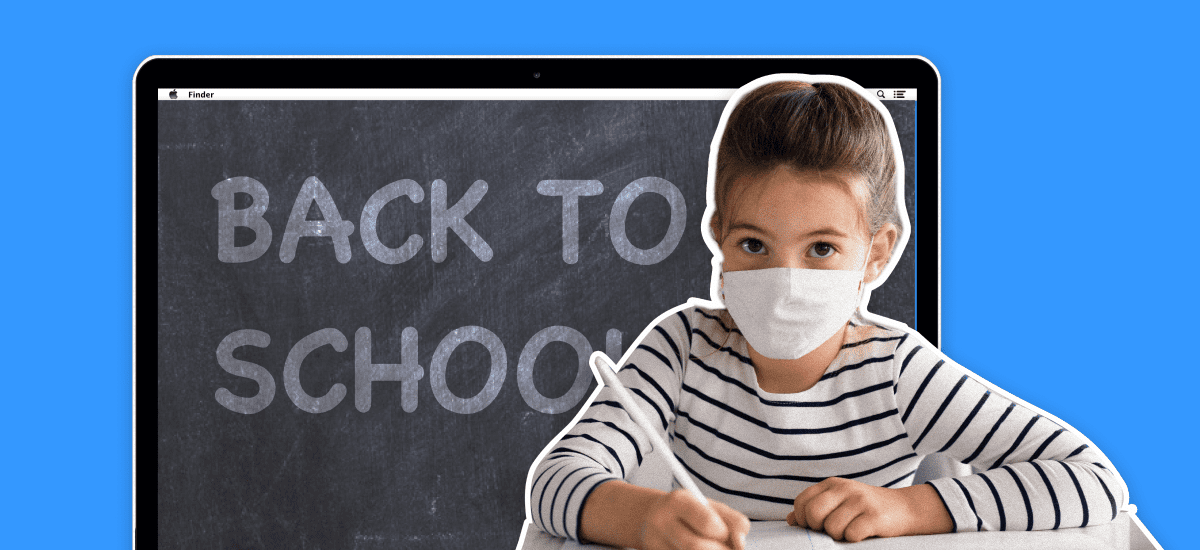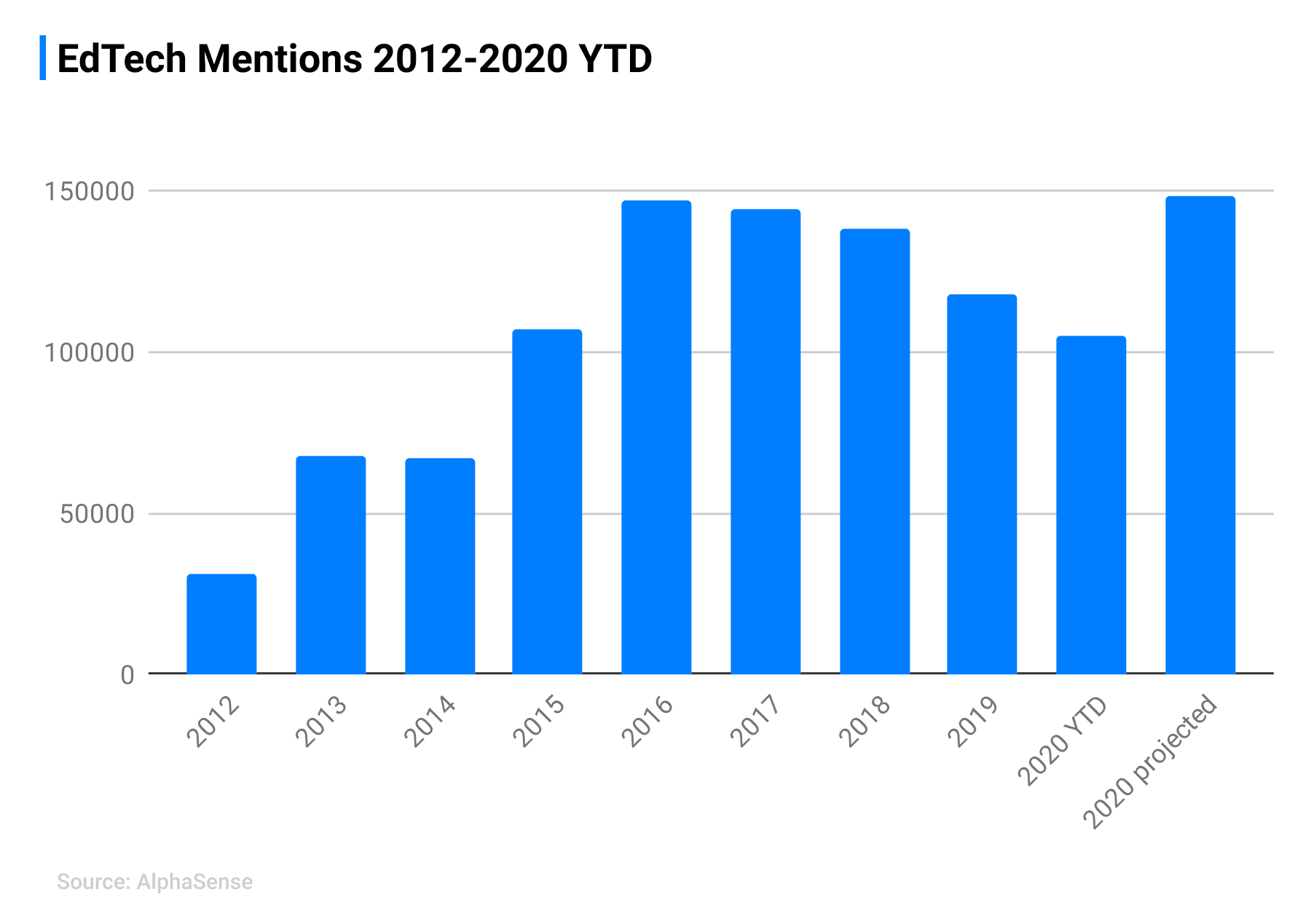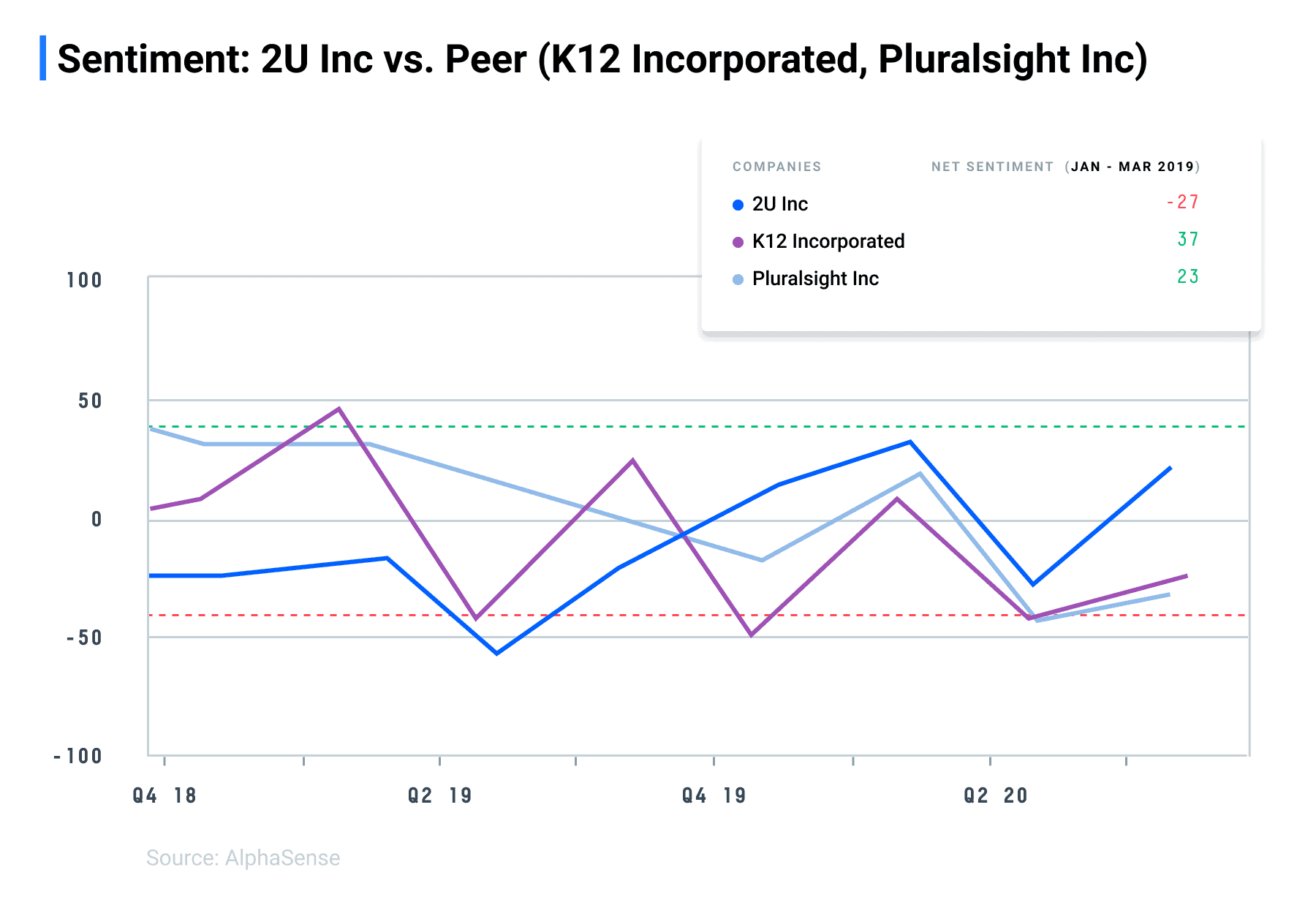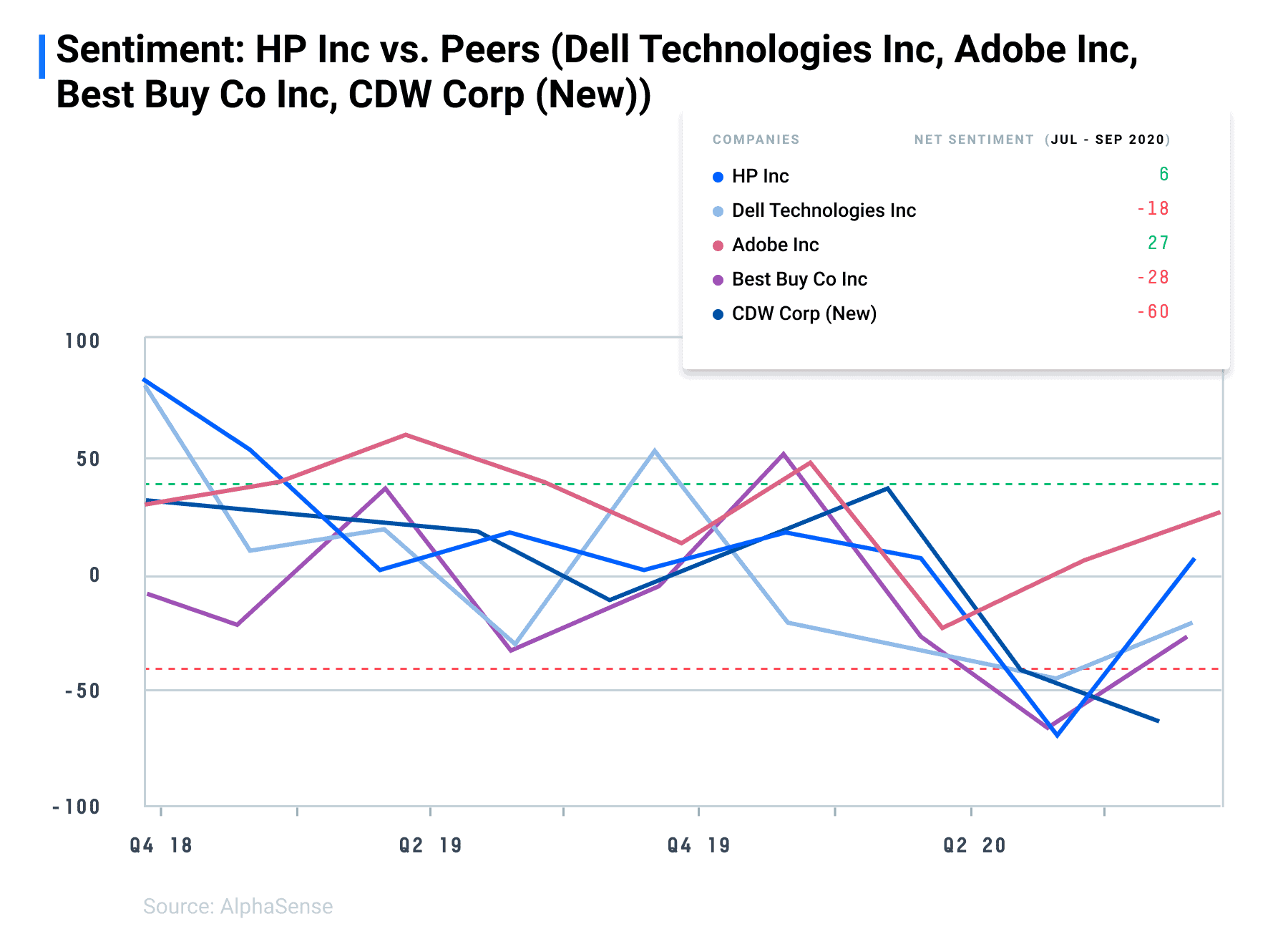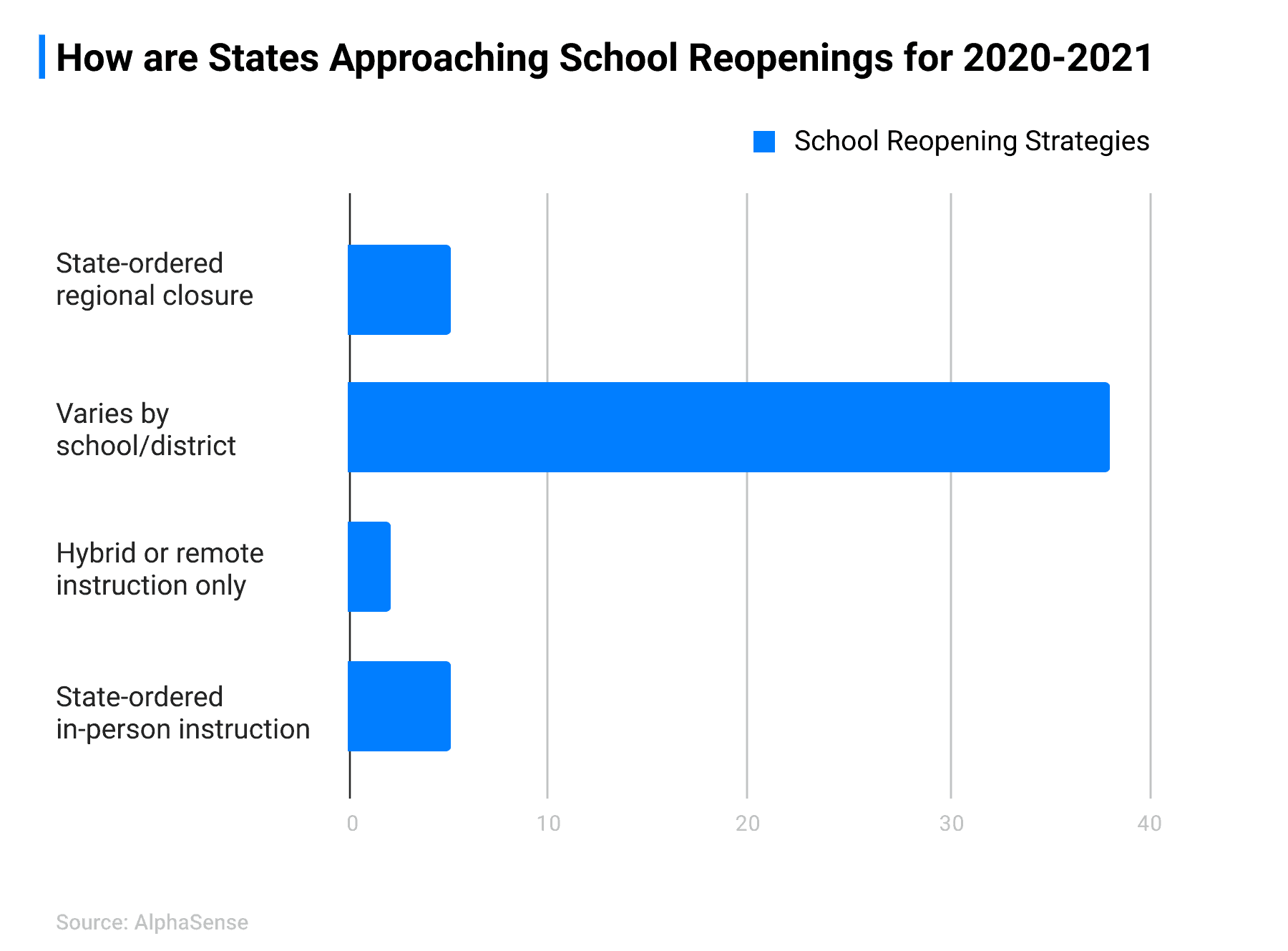As students return to classrooms, new cases of COVID-19 have emerged, forcing some schools to temporarily shift to online-learning only and hundreds of students to quarantine at home. A recent survey from The New York Times analyzed more than 1,600 American colleges and universities, revealing at least 88,000 cases; more than 61,000 of those cases came since late August with the start of the school year.
To meet the demand for online learning across all age groups and geographies, EdTech companies are evolving at a rapid pace. Below, we’ve compiled executive commentary from EdTech executives and others benefitting from this shift to digital learning– as well as a full breakdown of return-to-school policies by state.
To stay up-to-date on the return to the classroom and track real-time EdTech commentary, login to AlphaSense or sign up for a free trial.
Takeaways:
- As remote learning continues into the 2020-21 school year, EdTech companies like 2U and K12 have seen an increase in demand and sounded positive as it relates on the trend
- Devices makers, resellers and cloud providers have also benefited from the demand bump, sounding positive in earnings calls about how remote learning is impacting their business
- Projected EdTech mentions are up 25% YoY and are likely to reach an all-time high after a peak in mentions in 2016
- Almost every state has implemented remote learnings, alternating school days, delayed return to in-person education, and reduced classroom sizes
- Forty eight states closed schools for the 2019-2020 school year (Montana and Wyoming remained open/in-person); there are no state-ordered closures in the 2020-2021 school year
EdTech and remote learning mentions within company documents showed sharp YoY increases from 2012 through 2016 before beginning to decline in 2017. Due to the forced shift to digital education, EdTech is once again a growing topic, with mentions projected to overtake the 2016 high.
How have virtual education companies adapted to this landscape?
After an initial COVID dip seen across industries, three major EdTech companies, 2U, K12 and Pluralsight have all seen their AlphaSense Sentiment score bounce back as remote learning continues into the 2020-21 school year.
Below, you’ll see how executives have communicated this shift in demand has impacted their business.
2U Inc at Jefferies Software Virtual Conference – 9/14
We’ve been doing this 12.5 years. And that doesn’t change because there’s higher demand. So we’re being very careful in our choices. And demand is definitively up for our revenue share model. But as you know, that has a large J-curve.
So we’re being careful and thoughtful about what we do, but I guess I would say to folks take a look at what we did with Simmons University. It’s really quite incredible. I mean we took the entire university, every course they have, online for the fall, and we’ll be offering their programs for the undergrad market, which is by far the largest part of the space. If you think about U.S. higher education, $550 billion, the place that we play at historically is graduate education, and that’s $80 billion. And something on the order of 2% to 3% is digitized. So you’re talking about a really big TAM. And Simmons allows us to go at the largest part of the space with a partner that we have a great track record with. And for the first time ever, we’re actually taking a substantial campus revenue share as well. So we thought that was a really big opportunity.
K12 Q4 2020 K12 Inc Earnings Call – 8/27
Some key investments include a new mobile learning management system for the kindergarten to fifth grade learners, an adaptive algorithm that gauges and adjust the students reading levels and matches them to appropriate texts and new courses for our career pathways. Importantly, we also migrated most customer-facing applications to Amazon Web Services, or AWS. This change, in particular, supports our efforts to scale our business in a more cost-effective way as we ramp up enrollments and expand our business in the coming years.
Q2 2020 Pluralsight Inc Earnings Call – 7/29
From a content perspective, we definitely see the most demand in areas like cloud, data science, machine learning, AI and cybersecurity as well as our core sort of software development languages, frameworks that are sort of bread and butter for us. The big 3 are, obviously, very focused on the cloud today. And so we’re very focused there with them. That remains a top priority for us as a business.
We also see new opportunities in the other spaces I mentioned, like AI, data science, machine learning, cyber. And you also mentioned the interactive pieces or what we like to call the hands-on learning components of our platform, like our interactive courses and project experiences.
Those remain a very high priority for us today, and we’re intending to invest even more deeply in this hands-on domain in the quarters ahead, and it will be a big theme for us in 2021.
How are companies enabling the shift to remote learning responding to the demand uptick?
Following a similar trend as EdTech, device makers and resellers, as well as cloud providers, have seen remote learning become a driver of revenue, leading to an increase in QoQ Sentiment.
Below, we’ve compiled commentary on how the shift to digital-first education has impacted their bottom line.
Q2 2021 Dell Technologies Inc Earnings Call – 8/27
And the one that we haven’t talked about that has some headwind is the PC business. And we see a fundamental mix. While we’re seeing an incremental increase in unit demand based on the learn from home and the continued work-from-home phenomena that’s been underway, that is largely education-driven, that is largely lower-end ASPs that are associated with it.
Q3 2020 HP Inc Earnings Call – 8/28
In Personal Systems, we delivered another strong quarter, growing share, revenue and profit dollars. The business demonstrated its resiliency following the impact of COVID on supply chain issues in fiscal Q2. In Q3, Personal Systems benefited from strong demand related to working and learning from home with revenue of $10.4 billion, up 7% or 9% in constant currency.
Q2 2021 Best Buy Co Inc Earnings Call – 8/25
We’re seeing favorable trends across literally all of our categories right now as we exit Q2 and start Q3 with the one exception that we noted around mobile phones. But we’re seeing trends that are applicable to every part of learning, working, entertaining and cooking from home. And some of that, and to Corie and Matt’s prepared remarks, are impacted by the fact we don’t have as much inventory as we would like to have right now. But the demand curves that we saw when we opened our stores have continued as we’ve entered into August well beyond just the traditional back-to-school categories.
Q2 2020 CDW Corp Earnings Call – 8/5
But there is strong demand to get the kids in in-the-classroom environment, whether virtual or hybrid, as quickly as possible. So there’s a lot of pressure there, and they are accessing funds.
In higher ed, we’re seeing some pause on the budget side. Obviously, they’ve got concerns around various revenue streams. And the solutions side of the business there in terms of on-campus, robust network support, et cetera, has been stalling a little bit. But we are starting to see a pickup when it comes to remote enablement and devices and would expect that to continue as the schools get sorted out coming into this — the September-October time frame.
Q3 2020 Adobe Inc Earnings Call – 9/15
I think for both parents of young kids as well as those who have college-going kids, I mean, there is still quite a bit of uncertainty of what happens. But as it relates to the strength, I mean, we saw strength both in terms of students, educators as well as in institutions. And so we saw strength across the board. Part of what I would attribute that to is when it first struck and everybody works from home, if you have a young kid or a college-going kid, you want to continue to invest in making sure that they have access to the best software. I think we did a good job of provisioning Creative Cloud and ensuring that they have access to Creative Cloud.
And then we pretty actively went out with our field organization, both in terms of licensing products as well as the enterprise-site licenses that you can have for institutions to demonstrate it. And the last thing I would say is we are seeing more and more curricula in these institutions also add so much more on creativity as part of their curricula. So I think that’s a trend that is also helping our business.
How are states handling return to school?
How are states handling school reopenings for the 2020-2021 academic year?
| State | Return to School Status | Policy / Guidelines |
| Alabama | Varies by school/district | Parents who would prefer online education can opt for virtual learning. The state encourages schools to have virtual and in-person options. |
| Alaska | Varies by school/district | Each school district can decide on whether to reopen in-person learning or not |
| Arizona | Varies by school/district | Parents who would prefer online education can opt for virtual learning. The state encourages schools to have virtual and in-person options. |
| Arkansas | State-ordered in-person instruction | State-required reopenings for in-person classes all five days of the week. Each district can decide on when to return. |
| California | State-ordered regional closures | State’s new four-tiered framework, districts allows students into school buildings only if their counties meet key local metrics on coronavirus spread for two weeks. |
| Colorado | Varies by school/district | The reopening guidance for schools put out by the state recommends that districts have a variety of plans in place in addition to in-person classes, including teaching students in small groups and through distance learning. |
| Connecticut | Varies by school/district | Districts were asked to plan for all students to return to school for full-time, in-person instruction this fall as long as public health conditions support face-to-face teaching. |
| Delaware | Hybrid or remote instruction recommended | States to reopen schools with a mix of in-person and remote instruction, based on “minimal to moderate” viral spread among communities. |
| Florida | State-ordered in-person instruction | A state court judge on Aug. 24 issued a temporary injunction blocking a state emergency order requiring all brick-and-mortar schools to open at least five days a week. Districts will be able to make their own decisions about in-person learning. |
| Georgia | Varies by school/district | Districts will decide whether to open school buildings, open them on a limited basis as part of a staggered schedule, or use an all-remote schedule. |
| Hawaii | State-ordered regional closures | Schools may offer a blend of in-person and remote learning, but in others, due to rising coronavirus rates, they are allowed to teach only remotely. |
| Idaho | Varies by school/district | Schools are expected to welcome students for in-person instruction this fall, while adhering to public health guidelines and maintaining options for blended learning for students who don’t return and in case of a return to full-time remote learning. |
| Illinois | Varies by school/district | Districts can decide whether to open school buildings, following health and safety guidance from the state. However, the Illinois State Board of Education has |
| Indiana | Varies by school/district | School buildings were allowed to reopen starting July 1 per Gov. Eric Holcomb’s executive order, but districts set their own academic calendars and can make individual decisions about when or if students return to in-person classes. |
| Iowa | State-ordered in-person instruction | Gov. Reynolds, overriding local decisions, ordered every student to spend at least half of their schooling inside classrooms. Districts must also provide online classes for parents who demand it. |
| Kansas | Varies by school/district | The Kansas Board of Education voted July 22 to reject an order by Gov. Laura Kelly that would have delayed the start of school until Sept. 8. The vote put the decision on when to reopen back in the hands of local school districts. |
| Kentucky | Varies by school/district | Gov. Andy Beshear has recommended that schools should not begin in-person classes before Sept. 28. Once they return to buildings, all students, except those in preschool or kindergarten, will be required to wear masks in in-person classes. |
| Louisiana | Varies by school/district | While school districts can choose when to reopen, the state’s board of education has dictated a series of standards districts must meet before they reopen. |
| Maine | Varies by school/district | The state has approved all schools to offer in-person instruction this fall with required health and safety measures, but individual districts will make their own decisions. |
| Maryland | Varies by school/district | Local districts must submit plans for reopening by Aug. 14. The state allows districts to make plans for in-person classes, as long as they follow state and federal health recommendations. |
| Massachusetts | Varies by school/district | Districts and charter schools must finalize their return-to-school plans for in-person, hybrid and remote learning, submit them to the state department of education, and release them publicly. |
| Michigan | Varies by school/district | In-person learning can only occur in a region that’s in at least phase four of the state’s reopening plan. |
| Minnesota | Varies by school/district | Districts can determine whether to start the school year remotely, fully in-person, or in a hybrid model based on the number of new coronavirus cases in their county. |
| Mississippi | Varies by school/district | Districts may choose to open school buildings, but they must modify schedules, restrict gatherings, and observe social distancing in accordance with state and federal recommendations. |
| Missouri | State-ordered in-person instruction | Districts were required to open by Aug. 24, but could receive a waiver from the state’s department of education to open later. |
| Montana | Varies by school/district | The state department of education issued July guidance on four possible reopening scenarios, dependent on COVID case outbreak |
| Nebraska | Varies by school/district | State advises remote or hybrid learning plans in communities with significant or moderate spread. |
| Nevada | Varies by school/district | Guidance from the Nevada education department says school districts and charters must develop distance learning plans |
| New Hampshire | Varies by school/district | Local districts will decide whether they open for full-time, in-person teaching, continue with remote instruction, or employ a combination of the two as part of hybrid models. |
| New Jersey | Varies by school/district | Districts develop their own reopening plans. Schools can open as remote-only if they cannot meet health and safety standards for live instruction. Districts must lay out how they intend to address the health and safety challenges to move to in-person instruction. |
| New Mexico | State-ordered regional closures | School buildings serving grades K-5 and K-6 can open under a hybrid schedule so long as they are in counties that have demonstrated low enough rates of COVID-19 spread and the New Mexico Public Education Department has approved the school’s reopening plans. |
| New York | Varies by school/district | School districts across the state can reopen in-person in the fall, though that may be revised on a regional basis if COVID-19 infection rates increase. School systems will have to follow state guidelines, but the specifics of the plans–including whether teaching will be delivered in-person or via a hybrid model– will be up to the districts. |
| North Carolina | Hybrid or remote instruction only | Districts must offer online learning for students who are at higher health risks or who choose not to return. Districts can choose a fully-remote option if the infection rates in their area are high. |
| North Dakota | Varies by school/district | South Dakota’s state education department issued guidance that gives discretion to local districts to set restart plans in consultation with local health officials. It recommends flexible plans that prioritize face-to-face instruction. |
| Ohio | Varies by school/district | Districts will decide whether to open school buildings, but the state department of education has said that they should only do so if they can follow the state’s health and safety guidance. |
| Oklahoma | Varies by school/district | The state has advised districts in its reopening guidance to prepare alternate school calendars for potential school closures. Individual school districts will determine when to start school this fall. |
| Oregon | State-ordered regional closure | The state department of education outlines state and county COVID-19 metrics that determine whether districts can open buildings part-time, full-time, or not at all. Schools in areas that have seen three weeks of positivity rates and COVID-19 caseloads below public health benchmarks can begin reopening for in-person instruction. |
| Pennsylvania | Varies by school/district | State guidance allows school districts to decide whether they will use in-person or remote instruction, or a mix of both. |
| Rhode Island | Varies by school/district | Most schools have resumed classes. Districts that began the school year with hybrid or remote learning plans have until Oct. 13 to resume full in-person instruction. |
| South Carolina | Varies by school/district | Each of the 81 districts in the state has had its reopening plans approved by the state department of education, but only 1 in 5 plan to open full-time five days a week. |
| South Dakota | Varies by school/district | State recommends flexible plans that prioritize face-to-face instruction. |
| Tennessee | Varies by school/district | State provides a framework that districts can use to assess risk and decide when it would be safe to reopen. |
| Texas | State-ordered in-person instruction | School districts must provide daily, on-campus learning, however school systems can temporarily limit on-campus instruction for the first four weeks of school and beyond that with a waiver. |
| Utah | Varies by school/district | Districts must create and publicize plans for resuming in-person learning that address schedules, hygiene and safety, monitoring schools, |
| Vermont | Varies by school/district | State recommends full-time in-person learning “as soon as practical,” especially for students in Pre-K through Grade 5. Local districts currently make the decision on how to reopen. |
| Virginia | Varies by school/district | Schools across the state are open in various forms, depending on public health conditions. As of Sept. 8, most of the state’s school districts are operating in fully remote learning mode. |
| Washington | Varies by school/district | State officials announced Aug. 6 that they recommend schools in areas with high rates of new COVID-19 cases reopen with full-time distance learning for nearly all students. |
| West Virginia | State-ordered regional closure | Gov. Jim Justice has pushed the start of schools from August to a tentative start date of Sept. 8. The goal is to have in-person learning five days a week, but individual districts are formulating the details of such a plan. |
| Wisconsin | Varies by school/district | Districts will decide whether to return to full in-person instruction, stick to remote learning, or go with a hybrid model. |
| Wyoming | Varies by school/district | The state’s department of education is asking each district by Aug. 3 to send a detailed plan on how they will reopen their schools. |
